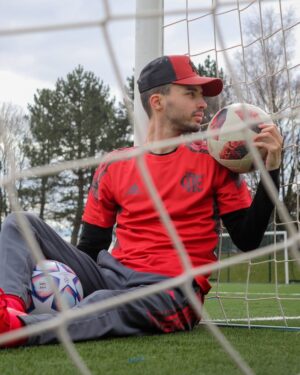Table of Contents
- So, can soccer players wear hats?
- Why don’t soccer players wear hats?
- What about during training sessions?
- Do soccer players wear gloves?
- What about caps in soccer?
- Recap: Can soccer players wear hats?
Welcome to this article, where we answer the question – can soccer players wear hats?
As you might be aware, one of the best things about soccer for beginners is that you don’t need a great deal of equipment to get started. Provided that you have some sports clothing and appropriate footwear, you can play soccer without much else!
But people who are new to the sport commonly ask, can soccer players wear hats? And if so, what’s the need for them? Read on to find out what the deal with hats in soccer is and when you might see a soccer player sporting a cap or hat on the field?
So, can soccer players wear hats?
The only soccer players on the field permitted to wear hats during a match are the two goalkeepers. This is necessary when the sun is shining directly into the goalie’s eyes, making it really difficult for them to see the ball coming toward them. Otherwise, soccer players aren’t permitted to wear hats in the outfield.
But why is this the case? And are there any exceptions to the rules? Let’s find out.
Why don’t soccer players wear hats?
The main reason why outfield soccer players don’t wear hats is that they’re not necessary. Also, heading the ball is an extremely important part of any soccer game, and if players routinely wore hats, it would make heading the ball much more difficult!
As such, soccer players are not permitted to wear baseball caps or beanie hats on the soccer field, and other than the goalkeepers, no players are permitted to wear headgear of any kind. This is stipulated in Law 4 of the Laws of the Game, under “player’s equipment.”
Also, there’s no need for soccer players to wear helmets, as is the case in football, as there’s less danger associated with head injuries. Should a player wish to wear any form of protective headgear, they must seek permission from the referee ahead of time, as the match officials have the final say in terms of what can and can’t be worn by players.
So, unless the goalkeeper requires a cap to keep the sun out of their eyes, you won’t see soccer players wearing hats of any kind during a game, as they’re not part of the standard uniform.
What about during training sessions?
On the training field, you might see soccer players wearing hats when they’re warming up, particularly during the cold winter months, specifically when it’s snowing. Coaches typically permit players to wear hats to help them keep warm and to ensure they’re engaged with the training.
Of course, it makes sense for players to wear beanie hats (or something similar) as opposed to caps, as these types of hats won’t restrict them when it comes to heading the ball, which is an important part of any training session.
Therefore, while you won’t see soccer players wearing hats during a competitive game, you might see them wearing certain types of hats during training sessions, particularly when the weather is cold.
Do soccer players wear gloves?
Although soccer players don’t wear hats (goalkeepers excluded), they do commonly wear gloves during competitive matches. In fact, when you watch a soccer match during the winter, it’s likely that most players on the field will be wearing gloves!
Soccer players are permitted to wear gloves, provided that they’re the same color as their jerseys and assuming that they don’t clash with the opposition’s uniforms. Players also wear gloves during training sessions to keep themselves warm!
Keen to learn more about why soccer players wear gloves and what the rules are surrounding them? Check out our article explaining what you need to know about wearing gloves on a soccer field.
What about caps in soccer?
You might have come across the term “cap” and wondered if it’s synonymous with hats. But in reality, a cap in soccer refers to the number of international appearances a certain player has for their national team.
So, for instance, if a player has played 100 times for their national team, they would be said to have 100 caps for their nation. The term comes from the fact that historically, players were issued real caps as a reward for representing their national teams.
This is a tradition that has been popular in many sports, including soccer and cricket. Players don’t wear the caps that they receive – they keep them as mementos. So, when you hear the term “caps in soccer,” know that it’s likely referring to the number of international appearances a player has, as opposed to headwear!
Keen to learn more about the tradition of awarding caps in soccer and where it came from? Check out our explainer guide to caps in soccer to find out what you need to know!
Recap: Can soccer players wear hats?
The bottom line is that the only soccer players that can wear hats during a competitive game are goalkeepers. They are permitted to wear caps to keep the sun out of their eyes, which is why you often see them wearing caps during the height of summer.
Other than this, soccer players don’t wear hats during competitive soccer matches. However, when training during the cold winter months, soccer players can wear hats to keep themselves warm!

